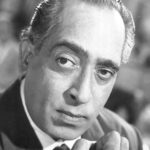Kishore Kumar wasn’t just a voice. He was an enigma — wild, unpredictable, hilarious, soulful, and heartbreakingly human. On the surface, he was Bollywood’s most loved playback singer. But behind the scenes was a man who lived by no one’s rules but his own.
Born on 4th August 1929 in Khandwa, Madhya Pradesh, as Abhas Kumar Ganguly, Kishore Kumar’s journey from a small-town boy to one of the greatest icons of Indian cinema is a story of pure instinct, talent, madness, and magic.

The Early Years: A Musician Without Training
Kishore moved to Mumbai to join his elder brother, Ashok Kumar, a big star at Bombay Talkies. But unlike his brother, Kishore didn’t want to act — he wanted to sing like his idol K.L. Saigal. With no formal training, he taught himself to sing by mimicking Saigal for hours.
In a twist of fate, the film industry first cast him as an actor, not a singer. His first acting role was in Shikari (1946), but he made a name with comic roles in films like Ladki, Naukri, and New Delhi — all while secretly dreaming of a singing career.
The Reluctant Actor, The Comedic Genius
Kishore Kumar never took acting seriously — which is why he was so good at it. His performances in Chalti Ka Naam Gaadi (with brothers Ashok and Anoop Kumar), Half Ticket (where he played both a man and a child!), Padosan, and Jhumroo were full of physical comedy, improvisation, and brilliant timing.
An interesting story: In Half Ticket (1962), he insisted on doing a scene where he dresses as a woman — and sang “Aake Seedhi Lagi Dil Pe” in both male and female voices. It became an iconic moment in Hindi cinema.
The Musical Breakthrough — And a New Era
In the 1950s and early 60s, Kishore sang occasionally, but the industry favored Mohammed Rafi and Mukesh. It was only in 1969 that his real turning point came.
Aradhana changed everything. R.D. Burman and S.D. Burman convinced producer Shakti Samanta to let Kishore Kumar sing for Rajesh Khanna. The songs “Mere Sapno Ki Rani”, “Roop Tera Mastana”, and “Kora Kagaz Tha Yeh Man Mera” became smash hits.
Suddenly, Kishore was everywhere — the new voice of romance, and the voice of Rajesh Khanna, Amitabh Bachchan, Jeetendra, and later Govinda and Anil Kapoor.
Love, Loss & Madness: A Life Off-Script
Kishore Kumar’s personal life was as colorful — and chaotic — as his career.
- He was married four times:
- First to Bengali singer Ruma Ghosh (1950–58), with whom he had a son, Amit Kumar.
- Then, famously, to Madhubala, the tragic beauty of Indian cinema. Their marriage was full of love but marked by her serious illness. He took her to London for treatment, but she passed away in 1969.
- His third marriage to Yogeeta Bali was short-lived.
- He finally found lasting companionship with actress Leena Chandavarkar, with whom he had another son, Sumit Kumar.
- Kishore was known for his eccentric behavior:
- He once put up a “Beware of Kishore” sign outside his house.
- He reportedly kept a tree in his living room and talked to it.
- When a producer didn’t pay him, Kishore arrived at the shoot with half his face shaved, saying he’d only finish the rest once his dues were cleared!
These antics were not for show — they were part of his deep mistrust of the film industry, where he felt exploited and misunderstood.
A Voice for Every Emotion
From the 1970s to the early 1980s, Kishore Kumar ruled playback singing:
🎵 Zindagi Ek Safar Hai Suhana
🎵 Pal Pal Dil Ke Paas
🎵 Khaike Paan Banaraswala
🎵 Yeh Shaam Mastani
🎵 Chingari Koi Bhadke
🎵 Humein Tumse Pyaar Kitna
🎵 O Saathi Re
🎵 Aanewala Pal Janewala Hai
He worked with every major music director — R.D. Burman, Laxmikant-Pyarelal, Bappi Lahiri, Kalyanji-Anandji, and even A.R. Rahman’s mentors.
He won 8 Filmfare Awards for Best Playback Singer and remains one of the most-streamed Indian artists decades after his death.
The Final Note: His Last Day
On 13th October 1987, Kishore Kumar suffered a heart attack and passed away at the age of 58. Ironically, it was the birthday of his elder brother Ashok Kumar.
As per his last wish, his ashes were immersed in the Khandwa river, in his hometown — a poetic return to his roots.
Kishore Kumar’s Legacy
Kishore Kumar defies definition. He could sing in joy and sorrow, dance in chaos, and bring tears with a whisper. He broke every rule in Bollywood — and yet became its most beloved voice.
Even today, his songs are played at weddings, on long drives, in lonely rooms, and late-night radio shows. Every emotion finds a home in his voice.
His son Amit Kumar continues the legacy, while tributes pour in from younger artists like Arijit Singh, Shaan, and Sonu Nigam, all of whom regard Kishore Kumar as the gold standard of playback singing.
“Zindagi ek safar hai suhana, yahan kal kya ho kisne jaana…”
That one line captures the essence of Kishore Kumar — spontaneous, full of wonder, fearless, and unforgettable.
At Nagpur Film Society, we bow to this mad, musical genius who gave us a lifetime of melody and mischief — a man who truly lived his own tune.


